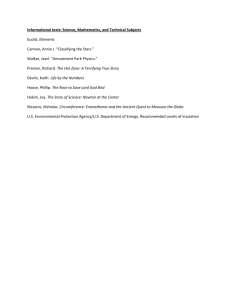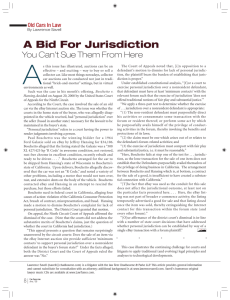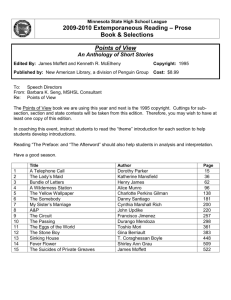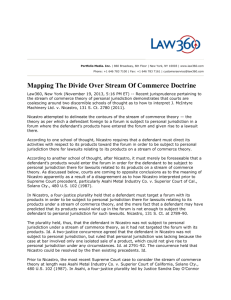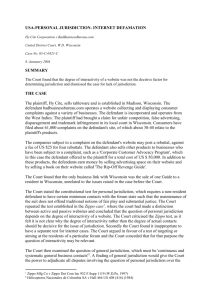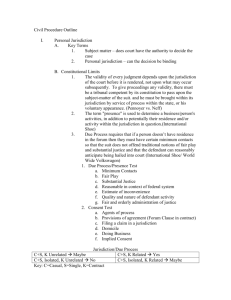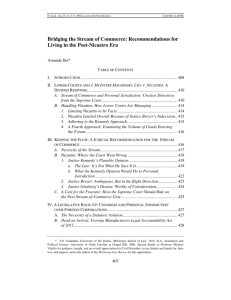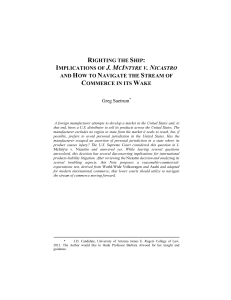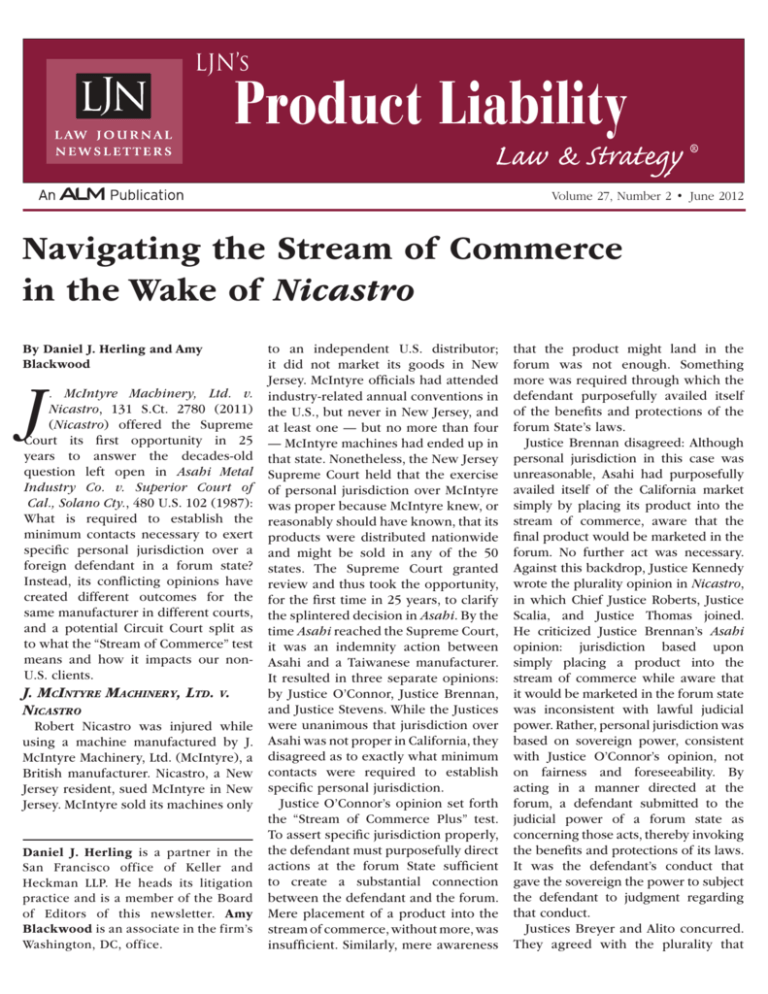
LJN’s
Product Liability
Law & Strategy
®
Volume 27, Number 2 • June 2012
Navigating the Stream of Commerce
in the Wake of Nicastro
By Daniel J. Herling and Amy
Blackwood
J
. McIntyre Machinery, Ltd. v.
Nicastro, 131 S.Ct. 2780 (2011)
(Nicastro) offered the Supreme
Court its first opportunity in 25
years to answer the decades-old
question left open in Asahi Metal
Industry Co. v. Superior Court of
Cal., Solano Cty., 480 U.S. 102 (1987):
What is required to establish the
minimum contacts necessary to exert
specific personal jurisdiction over a
foreign defendant in a forum state?
Instead, its conflicting opinions have
created different outcomes for the
same manufacturer in different courts,
and a potential Circuit Court split as
to what the “Stream of Commerce” test
means and how it impacts our nonU.S. clients.
J. McIntyre Machinery, Ltd. v.
Nicastro
Robert Nicastro was injured while
using a machine manufactured by J.
McIntyre Machinery, Ltd. (McIntyre), a
British manufacturer. Nicastro, a New
Jersey resident, sued McIntyre in New
Jersey. McIntyre sold its machines only
Daniel J. Herling is a partner in the
San Francisco office of Keller and
Heckman LLP. He heads its litigation
practice and is a member of the Board
of Editors of this newsletter. Amy
Blackwood is an associate in the firm’s
Washington, DC, office.
to an independent U.S. distributor;
it did not market its goods in New
Jersey. McIntyre officials had attended
industry-related annual conventions in
the U.S., but never in New Jersey, and
at least one — but no more than four
— McIntyre machines had ended up in
that state. Nonetheless, the New Jersey
Supreme Court held that the exercise
of personal jurisdiction over McIntyre
was proper because McIntyre knew, or
reasonably should have known, that its
products were distributed nationwide
and might be sold in any of the 50
states. The Supreme Court granted
review and thus took the opportunity,
for the first time in 25 years, to clarify
the splintered decision in Asahi. By the
time Asahi reached the Supreme Court,
it was an indemnity action between
Asahi and a Taiwanese manufacturer.
It resulted in three separate opinions:
by Justice O’Connor, Justice Brennan,
and Justice Stevens. While the Justices
were unanimous that jurisdiction over
Asahi was not proper in California, they
disagreed as to exactly what minimum
contacts were required to establish
specific personal jurisdiction.
Justice O’Connor’s opinion set forth
the “Stream of Commerce Plus” test.
To assert specific jurisdiction properly,
the defendant must purposefully direct
actions at the forum State sufficient
to create a substantial connection
between the defendant and the forum.
Mere placement of a product into the
stream of commerce, without more, was
insufficient. Similarly, mere awareness
that the product might land in the
forum was not enough. Something
more was required through which the
defendant purposefully availed itself
of the benefits and protections of the
forum State’s laws.
Justice Brennan disagreed: Although
personal jurisdiction in this case was
unreasonable, Asahi had purposefully
availed itself of the California market
simply by placing its product into the
stream of commerce, aware that the
final product would be marketed in the
forum. No further act was necessary.
Against this backdrop, Justice Kennedy
wrote the plurality opinion in Nicastro,
in which Chief Justice Roberts, Justice
Scalia, and Justice Thomas joined.
He criticized Justice Brennan’s Asahi
opinion: jurisdiction based upon
simply placing a product into the
stream of commerce while aware that
it would be marketed in the forum state
was inconsistent with lawful judicial
power. Rather, personal jurisdiction was
based on sovereign power, consistent
with Justice O’Connor’s opinion, not
on fairness and foreseeability. By
acting in a manner directed at the
forum, a defendant submitted to the
judicial power of a forum state as
concerning those acts, thereby invoking
the benefits and protections of its laws.
It was the defendant’s conduct that
gave the sovereign the power to subject
the defendant to judgment regarding
that conduct.
Justices Breyer and Alito concurred.
They agreed with the plurality that
LJN’s Product Liability Law & Strategy
mere foreseeability was not enough to
support personal jurisdiction. However,
they disagreed with the plurality’s
strict rule limiting jurisdiction to
situations in which the defendant
intended to submit to the power of a
sovereign and could be said to have
targeted the forum. Moreover, they felt
that Nicastro was an inappropriate
case in which to announce broad, new
jurisdictional rules; it did not present
facts demonstrating the fast-changing
globalization of the world economy
that might necessitate such rules.
Rather, Nicastro could be decided
by strict adherence to the Court’s
existing precedents which established
that jurisdiction should be based on
whether, considering the relationship
among the defendant, the forum State,
and the litigation, it was fair to subject
the defendant to suit in the forum.
Application of Nicastro:
Different Tests, Same
Defendant, Conflicting
Outcomes
As the lower courts begin to apply
Nicastro to the facts before them, circuit
court splits are already emerging. Every
court of appeals, and most district
courts to have considered the issue have
held that, at a minimum, something
more than “mere foreseeability” is
required to establish specific personal
jurisdiction. Most have held that Justice
Breyer’s concurring opinion states
the precedential holding of Nicastro.
Several have held that merely directing
conduct at the United States in general
is insufficient to establish specific
personal jurisdiction in any one state.
The Fifth Circuit is an outlier. Its preNicastro decisions had followed Justice
Brennan’s Asahi opinion. Thus, merely
placing a product into the stream of
commerce was sufficient as long as
the defendant knew, or reasonably
should have known, that the product
would be marketed in the forum state.
The Fifth Circuit Court of Appeals has
yet to issue an opinion interpreting
Nicastro, and although those district
courts that have, have continued to
hold to the “mere placement” test, the
decisions of the Southern District of
June 2012
Texas, at least, hint that perhaps the
test is becoming stricter. The Southern
District of Mississippi’s decision,
however, clearly exemplifies the
problems with Nicastro’s splintered
opinions and has been certified to the
Fifth Circuit for review.
‘Mere Foreseeablity’ … Plus?
On Jan. 18, 2012, Judge Ellison of
the Southern District of Texas granted
a motion to dismiss third-party
defendant HL (USA), a California
corporation, from a product liability
case arising from a bicycle accident.
Powell v. Profile Design LLC, No.
4:10-cv-2644, 2012 WL 149518 at *1
(S.D. Tex. Jan. 18, 2012). HL (USA)
argued that it was not subject to
personal jurisdiction because it was
not registered to do business in
Texas and had no product distributor,
bank accounts, phone numbers,
employees, offices, property, or
registered agent in Texas.
Judge Ellison’s opinion seemingly
begins by accepting Justice O’Connor’s
“Stream of Commerce Plus” test in
Asahi. He acknowledges that the
litigation must arise out of actions by
the defendant purposefully directed at
the forum State such that the defendant
had purposefully availed itself of the
benefits and protections of Texas law.
He notes that the Kennedy plurality in
Nicastro had held that a defendant’s
ability to predict that its goods would
reach the forum was insufficient for
personal
jurisdiction;
purposeful
availment was necessary.
However,
Judge
Ellison
then
recognized that the Fifth Circuit had
declined to follow Justice O’Connor’s
“Stream of Commerce Plus” rule from
Asahi. Justice Brennan’s more relaxed
“mere forseeability” test was the law of
that jurisdiction. If the defendant placed
a product into the stream of commerce
with the expectation that it would
be purchased or used in the forum
state, personal jurisdiction could be
exercised so long as the litigation arose
out of harm caused by the product. No
further act by the defendant directed
at the forum was necessary and, in
fact, personal jurisdiction could be
exercised based on activities directed
at a market broader than merely the
state in which the initial or direct sale
was made.
Nonetheless,
Judge
Ellison’s
holding appears to apply the
Nicastro plurality’s strict stream
of commerce test. In Nicastro, the
British manufacturer’s intent to sell
its machines to all willing purchasers
in the U.S. was insufficient to
establish personal jurisdiction. On
that basis, Judge Ellison held that HL
(USA)’s mere delivery of goods to a
U.S. distributor, while desiring those
goods to be distributed throughout
the United States, without more, was
similarly insufficient. There was no
evidence of the “something more” to
show that HL (USA) had undertaken
any
state-related
advertising,
marketing, design, or anything else
to demonstrate it had purposefully
availed itself of the privilege of
conducting activities in Texas.
This holding would seem to
raise the requirement for personal
jurisdiction to something more than
merely placing the product into
the stream of commerce. However,
Judge Ellison cabined his holding.
Immediately after stating that there
was no evidence of “something more”
to indicate purposeful availment, he
noted that there was also no evidence
that HL (USA) had placed its product
into the stream of commerce with the
expectation that it would be purchased
in Texas. The plaintiff had not met
its burden of showing that HL (USA)
was aware that its product was being
marketed in the forum state.
Mississippi and Kentucky: One
Defendant,
Two Outcomes
Nowhere has the hazards of a split
Supreme Court opinion been more
clear than in Lindsey v. Cargotec USA,
Inc., No. 4:09CV-00071-JHM, 2011 WL
4587583 (W.D.Ken. Sept. 30, 2011), and
Ainsworth v. Cargotec USA, Inc., 2011
WL 4443626 (S.D.Miss. Sept. 23, 2011),
both of which analyzed the propriety of
exerting specific personal jurisdiction
over defendant Moffett Engineering
LJN’s Product Liability Law & Strategy
Ltd., an Irish corporation. In Lindsey,
the Western District of Kentucky
held that it did not have personal
jurisdiction over Moffett. In Ainsworth,
the Southern District of Mississippi
held that it did.
Lindsey
In Lindsey, Judge McKinley first made
clear the Sixth Circuit’s preference
for Justice O’Connor’s “Stream of
Commerce Plus” approach to personal
jurisdiction. In the Sixth Circuit, merely
placing the product into the stream
of commerce was insufficient. Judge
McKinley acknowledged the split
between Justice Kennedy and Justice
Breyer in Nicastro and, because Justice
Breyer had concluded that Nicastro
could be decided on extant Supreme
Court precedent, concluded that the
Western District of Kentucky would
continue to adhere to the Sixth Circuit’s
analysis of purposeful availment.
Under that analysis, Lindsey failed to
show that Moffett committed sufficient
forum-directed acts to purposefully avail
itself of the benefits and protections
of the laws of Kentucky. Moffett’s only
contact in the U.S. was with Cargotec,
a separate corporation that distributed
Moffett’s forklifts. It claimed to have
no knowledge or control over where
in the U.S. Cargotec sold its products.
Moffett had no physical presence
in Kentucky, it had never sent any
employees to the state or sought
authority to conduct business there. It
had never shipped or sold any products
in Kentucky or directly solicited
business from any company located
in Kentucky. Moreover, Cargotec’s
activities in Kentucky could not be
imputed to Moffett. The companies
were separate corporate entities with
their own officers and directors and,
per their distribution agreement,
Cargotec was not an agent of Moffett.
Moreover, the distribution agreement
between Moffett and Cargotec did not
provide a basis for jurisdiction: Moffett
had no ability to control Cargotec’s
distribution in the U.S.; it had no
involvement in its advertisement and
no communication with, or knowledge
of, its customers. Any knowledge by
June 2012
Moffett that its products would be
distributed and sold in the U.S. by
Cargotec was insufficient to show
purposeful availment of Kentucky as
the forum State.
The outcome in Ainsworth was
entirely
different
because
the
test applied was different. After
summarizing the Supreme Court’s
opinions in World-Wide Volkswagen
Corporation v. Woodson, 444 U.S.
286 (1980), and Asahi, Judge Starrett
noted that the Fifth Circuit followed
Judge Brennan’s “mere foreseeability”
test outlined therein. As Texas Judge
Ellison had ruled, in the Fifth Circuit,
“mere foreseeability” or awareness
by the defendant that its product
would arrive in the forum State
through the stream of commerce
was constitutionally sufficient for
personal jurisdiction. Judge Starrett
acknowledged that Justice Kennedy’s
concurrence in Nicastro eschewed
Justice Brennan’s “mere foreeability”
test in Asahi, but Justice Breyer
had elected to simply follow prior
precedent. Justice Breyer’s opinion
was narrower than the plurality’s and
therefore reflected the binding opinion
of the Court. But since Justice Breyer
had declined to choose which Asahi
plurality opinion controlled, Nicastro
was, in Judge Starrett’s view, rather
limited in its applicability and did not
provide grounds to depart from the
Fifth Circuit’s precedents.
Therefore, Judge Starrett applied
Justice Brennan’s “mere foreseeability”
test to the case before him. Since
Moffett knew its products would
be marketed throughout the United
States and made no attempt to limit
Cargotec’s marketing efforts, it was
foreseeable that its products would be
purchased in Mississippi. Therefore,
personal jurisdiction over Moffett
was appropriate.
Following that decision, Moffett
requested that the court certify its
opinion for Interlocutory Appeal.
Judge Starrett agreed that his earlier
opinion
involved
a
controlling
question of law: Whether Nicastro
altered the Fifth Circuit’s adherence to
Justice Brennan’s “mere foreseeability”
stream of commerce theory. Clearly,
as to Moffett, the outcome of that
question controlled the outcome
of the case. In analyzing whether
that controlling question was one
about which reasonable jurists could
disagree, Judge Starrett acknowledged
the multiple district court opinions
within the Fifth Circuit, many of which
had reached conflicting opinions as to
the effect of Nicastro on the viability
of Justice Brennan’s test.
Judge Starrett stated his personal
view: that his prior opinion was
correct and that Nicastro had little or
no precedential value, but recognized
that there existed substantial ground
for a difference of opinion. On that
basis, he certified his opinion for
Interlocutory Appeal.
Interlocutory Appeal
The
Interlocutory
Appeal
in
Ainsworth presents the Fifth Circuit
with the opportunity to decide whether
it will continue to follow Justice
Brennan’s “mere foreseeability” rule
from Asahi. If it does, it will be the only
circuit court of Appeals since Nicastro
to so hold. Perhaps the ensuing circuit
court split will prompt the Supreme
Court into, finally, determining the
requirements and boundaries of the
stream of commerce.
In the meantime, the issue of
jurisdiction for non-U.S. defendants
will be fact- and circuit-driven.
—❖—
Reprinted with permission from the June 2012 edition of the
Law Journal Newsletters. © 2012 ALM Media Properties, LLC. All rights reserved. Further duplication without permission is prohibited. For information, contact 877.257.3382 or
reprints@alm.com. #055081-06-12-03

